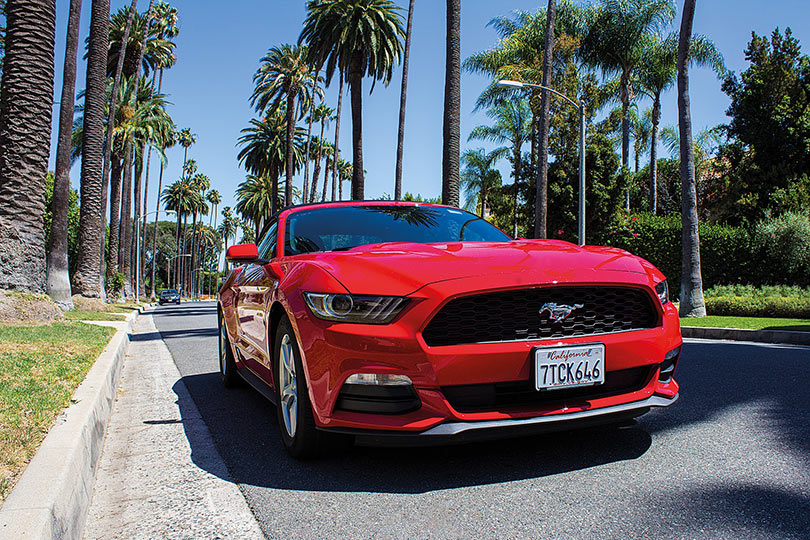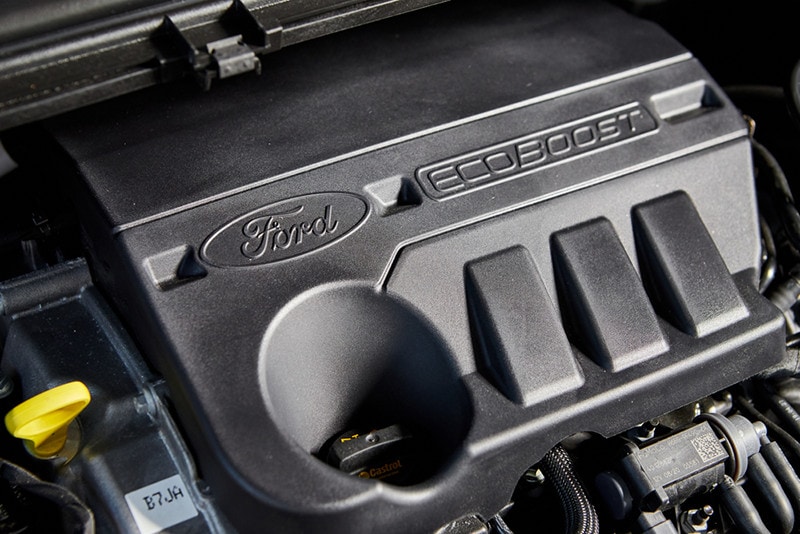What Is a Coyote Engine? How Does It Work?
-
Pete Ortiz
- Last updated:

Ford is famed for producing legendary cars and perhaps one of the earliest companies to automate a good percentage of production lines, pay workers handsomely and meet growing market demands. Currently, the company continues to stand apart from the rest by continuously inventing better and more powerful engines, from EcoBoost to Coyote engines.
Coyote engines are modular V8 beasts whose production started in 2010. The engine has a modest displacement of 5.0L and aspirates naturally. Despite the small size, the engine is powerful enough to smoke out over 410 horsepower, better than the outgoing 4.6L V8 engine.
It features twin independent Variable Cam Timing (Ti-VCT) and Cam torque actuation technologies to speed up Ford Mustangs and F-150 trucks at over 160 mph. But to Ford enthusiasts, Coyote is more than an engine. It is a remarkable invention that has very many unanswered questions.
How Does a Coyote Engine Work?
When the Coyote was being designed, it was fitted with an entirely new cylinder head that the outgoing engine did not have. Each cylinder has four valves and dual overhead cams.
While its predecessor had variable cam timing, power production and efficiency were limited because the intake and exhaust valves moved at the same time. The Coyote engine provided incredible versatility thanks to the Ti-VCT technology. Intake and exhaust valves could now be actuated by different camshafts and high-tech computer software. If you don’t get how this works, let us simplify it a little bit.
The most crucial set of this engine is the dynamic nature of power production achieved by how independent the camshaft and valves are moving. Utilizing these ingenious features makes the lobe separation angle (LSA) more dynamic. Suppose you draw a straight line that divides the intake lobe into two equal parts at the maximum lift and do the same for the exhaust lobe; the two lines meet at a point where they form the LSA. The significance of having a dynamic LSA is you can advance or retard horsepower and torque depending on how you are driving.
In the past, the fixed LSA angle was either too wide or narrow. Wide LSA translated to lower RPM, which equated to high torque and less horsepower. In contrast, narrow LSA increased RPM and horsepower at the expense of low torque. So, drivers had to sacrifice one to benefit from the other.
With Ti-VCT technology, drivers benefit from both worlds. Reduce the LSA and boldly drive with more horsepower; increase it, and you have more torque to accelerate faster.
Another impressive feature of this engine is the charge motion control valve system (CMCV). Though the technology existed in earlier models as intake manifold runner control (IMRC), it was comprehensively updated in 2015s for third-generation Coyotes. The feature partially closes butterfly valves when the engine’s revolution stalls to increase air tumble in the combustion chamber. This leads to the formation of a homogeneous fuel-air mixture for complete combustion, stabilized idling, reduced emission, and better fuel economy.
Having explored some of their futuristic technologies, Coyotes work like any other internal combustion engine. They obtain energy by internally combusting fuel in the presence of air.
As you turn on the ignition key, the fuel pumps start pushing gasoline through fuel lines to the engine. The engine has a standard port-style fuel injection system that squirts fuel directly on the intake valves. The valve’s high temperature heats up and atomizes fuel before being pushed into the cylinder, where it will mix with air.
This unique design is one of the many direct injection systems that doesn’t need a carburetor to work.
Through piston movements, a swirling effect homogeneously mixes fuel and air, which is then compressed in a ratio of 11:1. A spark plug then ignites the mixture by sending a powerful spark into the combustion cylinder.
Normally, when gasoline combusts, it produces a lot of heat which, if it happens in an enclosed environment such as the inside of a cylinder, increases pressure. The resulting force is what pushes the piston downwards to rotate the crankshaft. The crankshaft will convert reciprocating motion into rotational motion to rotate the wheels.
After every combustion stage, gasses must be released through exhaust valves into the exhaust pipes. Depending on a country’s regulation and engine mode, exhaust gasses may pass through NOx and particulate filters to remove harmful compounds and soot.

What Are the Different Types of Coyote Engines?
Coyote was Ford’s answer to growing opposition from Dodge Challenger and Viper. But like its competitors, the engine had a great start, and Ford diverged its production across three generations and various variants.
1. Gen 1 Coyote
Generation 1 Coyote featured similar aspects as traditional modular engines and was available from 2011 to 2014 in Mustang GTs. However, subtle changes, including power boosts, were obvious. The engine was released with a varying horsepower of between 410 and 420 and an improved torque of 390 lb.-ft.
All Gen 1 Coyotes were made of cast aluminum and had a 92.2 mm bore and 92.7 mm stroke. Use these values to calculate the volume of a single cylinder and multiply by eight, and you will get a displacement of 4.951 L, which is theoretically 5L.
We won’t chase the engine’s technical details down the rabbit hole, but all Coyotes have four valves per cylinder. At 37mm, the intake valve of gen 1 is slightly wider than the exhaust valve, which measures 31mm.
In 2013 and 2014, Ford tweaked the engine a little bit. They removed cooling oil squirters and boosted horsepower to 420.
2. Road Runner
This is a special edition engine on the Gen 1 platform installed in the 2011 and 2012 Boss 302 Mustang, a high-performance car with a vintage 1970 Mustang body. It aspirates naturally and can stagger to 8400 rpm to roar out up to 444 horsepower.
Due to this modification, torque dropped from 390 to 380 lb.-ft.
3. Gen 2
Gen 1 engine saw a major overhaul between 2015 and 2017 to serve as a powerhouse for 2015 Mustangs. The primary aim of the updates was to allow the engine to breathe better. Piston tops were designed with deeper valves to lessen intake and exhaust restriction. The combustion chamber was modified to accommodate the new valve, but the compression ratio of 11:1 remained unchanged.
Topping up gen 2 was a new composite manifold that incorporated advanced CMCV, which increased swirling for better air-fuel mixing. All these changes raised the horsepower and torque to 435 and 400 lb.-ft, respectively.
4. Voodoo
After the release of gen 2 Coyote, Ford revolutionized manufacturing by producing the most radical naturally aspirated engine. It was codenamed ‘Voodoo’ for good reasons. The Voodoo cast its witchcraft to 526 horsepower at 7500 RPM and 429 lb.-ft of torque at 4750 RPM. Instead of using a traditional cross-plane crankshaft, this engine was equipped with a flat plane benchmarked from a Ferrari California.
In 2013, the keen expertise invested in Voodoo earned it Ward’s Ten Best Engines award.
5. Gen 3
The biggest change in the Coyote engines debuted in the 2018 Mustang GT. With the engine now boasting 5.045L displacement, the cross-plane crankshaft was revised to support higher RPM. And at 7,000 RPM, the engine could easily produce 460 horsepower and 420 lb.-ft of torque at 4,600 RPM.
Where Is It Used?
The main purpose of the Coyote engine was to replace the 4.6L and 5.4L Modular V8 units in most Ford vehicles and be better placed in the growing competition. The engine is the primary powerhouse in Mustang GTs, Boss 302s, BULLITTs, and Mach 1s. F-150 trucks also enjoy their immense power.
A lesser-known variant of Coyote, Miami, is being sold in Australia for Ford Falcons and FGX XR8.
Lastly, outside Ford, the engine was tuned by Cosworth for TVR Griffith and is the main driving force behind Panoz Esperante cars.
Advantages of a Coyote Engine
Increased Engine Efficiency

The volumetric efficiency of the Coyote engine is high because of the dual overhead camshaft (DOHC) design which controls the movement of the intake and outlet valves independently. This design increases the volume of air that flows into the combustion chamber, thereby increasing the engine’s power.
Higher Torque at Your Disposal
Coyote engines implement TI-VCT technology which enables the engine to have a dynamic lobe separation angle (LSA). The major advantage of a dynamic LSA is that the engine can independently control how the intake and outlet valves open. This directly translates to higher torque and horsepower depending on the RPM. Furthermore, the TI-VCT technology improves fuel economy and reduces emissions from the engine.
Reliable Horsepower
Coyote engines have very high engine horsepower. Initial models had an average horsepower of 420. The 2015 Mustang GT had 435HP. Currently, the Coyote 5.0 powered Mustang boasts a dyno run of over 950 horsepower!
High RPM
Another advantage of the Coyote engine is its high RPM. An engine’s RPM measures the number of full rotations the crankshaft makes in a minute. So as you press the accelerator, the car’s RPM increases, increasing power. The Predator model of the third generation Coyote engine has a staggering 7,300 RPM!
There Is Plenty of Space for Customization
Coyote engines are easily modifiable. The engine is constructed in a modular design that has wide room for after-market variations and tuning. Depending on the need, you can easily modify engine parts by swapping them with other parts. This feature enables owners of a Coyote engine to keep their engine status up-to-date without replacing the old one completely.
Disadvantages of a Coyote Engine
Large Engines
For the Coyote engine to perform incredibly well, it needs extra installations and parts such as the double overhead camshaft and a larger combustion chamber. As a result, the engine is physically larger. This makes it difficult to update the vintage Mustang models with the new, more powerful Coyote engine.
Uncomfortable Piston Slaps
Some models of the Coyote engine, like those in the 2018 Mustang GTs, suffer from piston slap. A piston slap occurs when the piston repeatedly hits the combustion cylinder wall after a cold start. The repeated hitting causes a ticking and uncomfortable grinding noise.
Fuel Pressure Sensors Issues
Coyotes have very effective fuel pressure sensors (FPS) but due to high-octane engine power and dazzling RPMs wear out very quickly.
Despite sensors lasting for the life of the engine, in Coyote, you will replace them severally, and the complex process takes an experienced mechanic more than 5 hours.
If you are using a faulty FPS, you will notice sudden RPM surges, which affect acceleration and torque.
Constant Stalling

Mustang owners, especially F-150 drivers, complained that their vehicles lost speed and stalled out. Before stalling, they reported that the engine sputtered fast. The main reason behind these abnormal occurrences is unknown, and also Ford is yet to acknowledge the problem.
FAQs
How Did Coyote Get Its Name?
It was named after Ford’s first-ever four-valve eight cylinders engine, Coyote 67, in a race car driven by AJ Foyt in the late 60s and early 70s.
Are There Supercharged Coyote Engines?
Supercharged Coyotes exist. Ford Falcon XR8 runs on supercharged engines with a peak output of 403 horsepower.
Conclusion
Coyote is a modular V8 engine designed and built by Ford in 2010 for Mustangs and F-150 trucks. It displaces around 5L, and along its revolutionary journey, several variants have been released. Miami, Road Runner, Voodoo, and Predator are a few of them. The main engine has also received major updates from the gen 1 build in 2011 to the most recent gen three debuted in 2018.
The Coyote is a powerful engine capable of wheeling out over 400 horsepower and 380+ lb.-ft. Having these impressive features, you will also find the Coyote in Panoz Esperante and TVR Griffith cars. Despite the liking, the engine experiences stalling and require minor replacement throughout its life. But these cons don’t override its impressive power output and RPM.
See also:
Featured Image Credit: BKD, Pixabay
Contents


